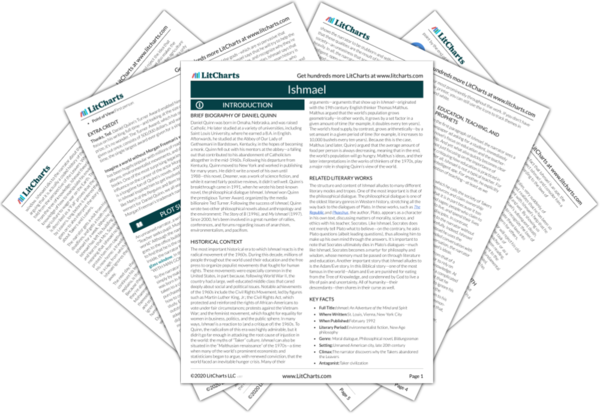Education, Teaching, and Prophets
In the first paragraph of Ishmael, the narrator sees a newspaper ad asking for a student, immediately establishing the novel’s focus on education and the teacher-student relationship. And yet what also quickly becomes clear is that the novel is not just focusing on the importance of education, but rather critiquing how education is practiced in the modern world. After all, Ishmael is not a typical teacher. For one thing, he’s a super-intelligent ape. For another…
read analysis of Education, Teaching, and ProphetsInterconnectedness
At the beginning of the novel, the narrator is a self-described misanthrope. He seems to have no close friends, and the only family member he mentions (very briefly) is an uncle, for whom he seems to have no affection whatsoever. He lives his life “cut off” from other people. The narrator’s education under Ishmael changes his outlook. At the same time that the narrator learns about man, the gods, and nature from Ishmael, he comes…
read analysis of InterconnectednessFiction, Storytelling, and Truth
Ishmael uses a fictional plot and characters to put forth philosophical ideas more commonly found in a work of nonfiction. This brings up an important question: why does the author of the novel, Daniel Quinn, use fiction to communicate his message? (Why didn’t he write a philosophy book instead?) What’s the relationship between fiction, storytelling, and truth?
In an early chapter of Ishmael, Ishmael argues that human beings feel an irrepressible need to tell…
read analysis of Fiction, Storytelling, and Truth
Cynicism, Misanthropy, and the Failure of the 1960s
On the first page of Ishmael, a newspaper ad asks the narrator to come to a mysterious building in order to “save the world.” When the narrator arrives at this building, he is amazed to find that no one else is there. Throughout Ishmael, it’s suggested that people have already tried to save the world, failed, and given up altogether. The narrator argues that the last great attempt to save the world occurred…
read analysis of Cynicism, Misanthropy, and the Failure of the 1960sImprisonment
From the moment that the narrator sees Ishmael in his room, he becomes aware that Ishmael is in prison. It’s only later that he realizes that this prison is self-imposed. Ishmael is sitting behind a glass window because he chooses to do so—his friend and former pupil, Rachel, is paying for the building where he’s being “kept.” Even later, when Ishmael is moved to a more literal prison—a cage at a carnival—the narrator recognizes…
read analysis of ImprisonmentHumans, the Environment, and Extinction
Following World War II, the world population exploded. Across the planet, especially in the Third World, populations were larger than they’d ever been—and were growing at a faster rate than they’d ever grown before. At the time when Ishmael was published, in 1981, many sociologists worried that the rise in world population would eventually cause a global food crisis, and perhaps even the extinction of the human race. It’s worth looking at this notion more…
read analysis of Humans, the Environment, and Extinction






